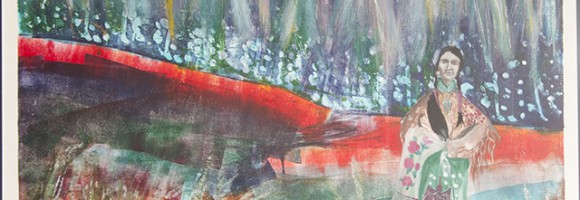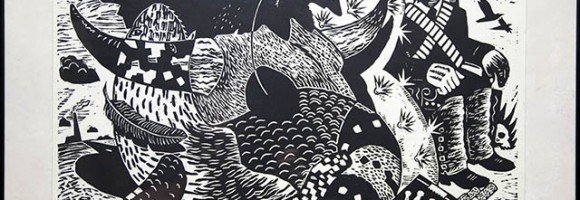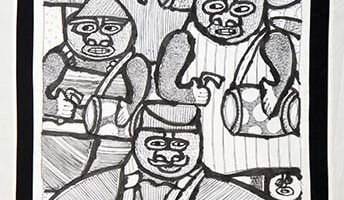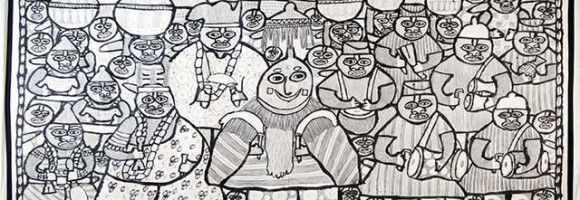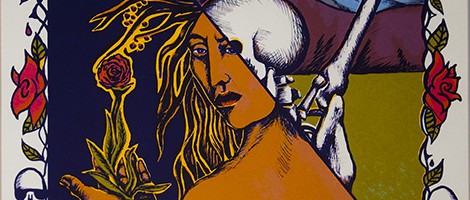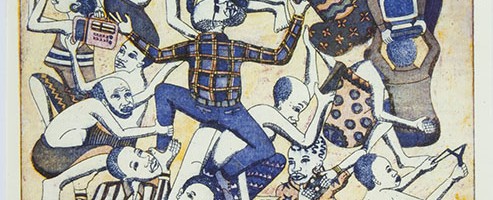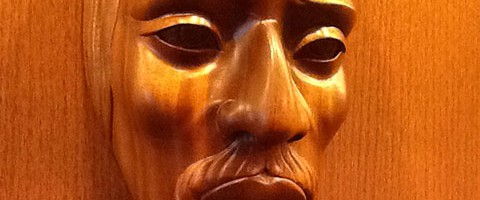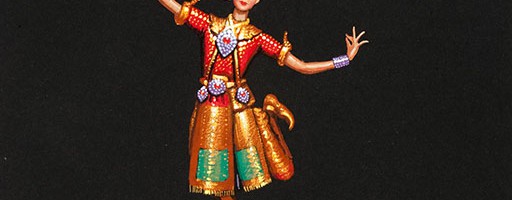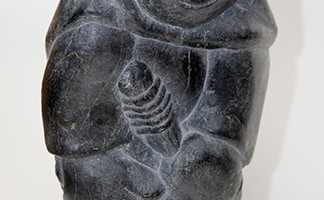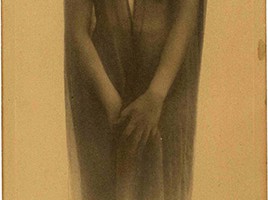Damian Charette
These prints are by a group of artists I have become close with since moving to Arizona in 2001, most of which have exhibited work at Promega. All of these artists belong to several organizations comprised of Latino and American Indian artists in the Phoenix area.
I’ve come to find a very rich art scene in Arizona, much as I did living in Kenya years ago. In both places, I became involved with and had the good fortune to work with artists and to exhibit their work.
I have encountered great artists all over the world and have somehow managed to end up with a diverse collection of art pieces to remind me of those relationships. By far, the most interesting and valuable aspect of what I do is getting to know unique and fascinating people.
Ke’t Lars’n
I acquired this print at an estate sale about two years ago. Although I have little information regarding this piece, I clearly see the quality of the wood-cut block print and venture to guess it depicts the story of a past conflict in the area of Douglas and Agua Prieta.
Despite being recently formalized as sisterhood cities, the border town of Douglas, Arizona and the adjoining city of Agua Prieta, Sonora in Mexico have historically been hosts to a variety of conflicts.
Michael Ayodele
These two drawings are by a Nigerian artist named Michael Ayodele. I acquired these at an auction at the University of Wisconsin-Madison.
The narrative of these graphics is quite extraordinary. Like many African artists, Michael tells contemporary stories with a traditional slant. Although I was unable to find much information regarding the artist and his background, I have seen other Nigerian artists doing similar work. An artist by the name of Twins Seven Seven would be the most famous of this group.
Find out more about Modern African Art.
Michael Ayodele
These two drawings are by a Nigerian artist named Michael Ayodele. I acquired these at an auction at the University of Wisconsin-Madison.
The narrative of these graphics is quite extraordinary. Like many African artists, Michael tells contemporary stories with a traditional slant. Although I was unable to find much information regarding the artist and his background, I have seen other Nigerian artists doing similar work. An artist by the name of Twins Seven Seven would be the most famous of this group.
Find out more about Modern African Art.
Martin Moreno
These prints are by a group of artists I have become close with since moving to Arizona in 2001, most of which have exhibited work at Promega. All of these artists belong to several organizations comprised of Latino and American Indian artists in the Phoenix area.
I’ve come to find a very rich art scene in Arizona, much as I did living in Kenya years ago. In both places, I became involved with and had the good fortune to work with artists and to exhibit their work.
I have encountered great artists all over the world and have somehow managed to end up with a diverse collection of art pieces to remind me of those relationships. By far, the most interesting and valuable aspect of what I do is getting to know unique and fascinating people.
Robino Ntila
Robino Ntila is an artist based in Tanzania. He works with artists all over Africa, conducting printmaking workshops, mostly with the support of the Ford Foundation. He has taught many artists how to print, helping them market their work in the process.
Robino worked closely with the famous Makonde artist George Lilanga, teaching him the art of printing. Lilanga, one of the few early carvers able to transition from three-dimensional to two-dimensional work, made the transition from carver to visual artist in a movement called Tinga Tinga. His distinct style characterized the start of the movement in Tanzania, one which Ntila continues today, alongside Lilanga’s son.
I met Robino Ntila in Nairobi in 1994. I have more than one hundred Ntila prints, as the artist used to send them to me once a year. Today, Ntila has taken to painting, and thus no longer sends me etchings.
Zarco Guerrero
In the fall of 2008, Promega displayed a number of Zarco Guerrero’s masks alongside the photography of his uncle, Pedro E. Guerrero. I got to know Zarco just after moving to Arizona in 2001. When I realized Zarco and my friend, Pedro, were related, I proposed creating an exhibition involving the talented Guerrero family.
Zarco Guerrero is a multi-talented artist, best known for his masks. You can see the Japanese influence in his method of carving, as he studied there. Most of his masks are made for live performances and meant to be worn. Zarco supplies masks and costumes for performances all over the world.
Artist Unknown
These five depictions are part of a group of 13 paintings with origins in Thailand. Like many artistic works, art of this genre looks great framed. Done on black background, the images almost bounce of the surface of the painting.
These paintings were most likely made for tourists and represent nice remembrances of past travels. Although I bought them for no specific reason, I find them to be nicely rendered and hope they will eventually find a home. In the meantime, here they are for your enjoyment.
Artist Unknown
Zimbabwean Stone sculptures are often called Shona Sculptures. Zimbabwe, a southern African country whose name literally means “the house of stone,” is known for its remarkable stone sculptors. The Shona sculptors’ work is often inspired by deeply-held spiritual beliefs, folklore and daily life, and have in turn inspired many western artists. While modern in inspiration, Shona sculptures are created much as they were in the past, using simple chisels to “release” the spirits of the stone.
For more information on Shona Sculptures, click here.
Inuit art, produced by the people of the Arctic, are historically carved from walrus ivory. Since the establishment of southern markets for Inuit art in 1945, however, the use of soft stone such as soapstone, serpentine, or argillite for the carving of figurative works has increased in popularity.
For more information regarding Inuit Stone Sculptures, click here.
Artist Unknown
These three items are part of an assortment of Wyatt Earp works I have collected in the last fifteen years. Since moving to Arizona, I have been able to more thoroughly research Old West historians. Last year, Promega showcased historical photos of Arizona from the collection of Jeremy Rowe and Jeremy, for one, has written extensively about this photo of Wyatt Earp’s wife.
This photo, called Kaloma, depicts the woman thought to be the wife of Wyatt Earp. I found it in Greece in 1997 at an antique shop located in downtown Thessaloniki. The one displayed is a reproduction, since the original is too fragile to display for three months. The controversy about the true identity of the woman depicted in the photo is typical of Old West lore and embellishments of the truth about that time in our history.
The photograph of Jennifer Tilly posing in reflection of Kaloma is by John Beckett. This and other shots from the same photo shoot can be found in the issue of True West magazine currently located in the Promega library. This issue of True West was the fastest selling issue they have ever had.
I own various books and a collection of over 600 negatives from Tombstone, AZ circa 1915. I have been working with the Historical Society there to preserve these images. Last year I stayed at an RV camp in Tombstone. It took me about one hour of sitting on a bench and talking to locals to connect with just about everyone who claimed to be an expert of the history of The Shootout at the OK Corral nearby. Tombstone, “The Town Too Tough to Die,” is my favorite bit of Americana.
